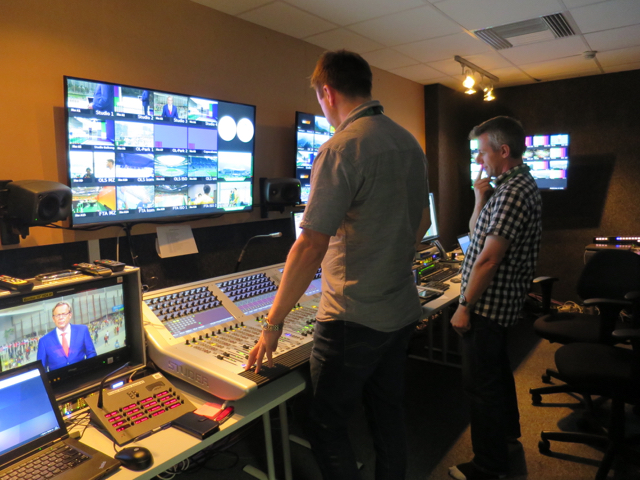Live from Rio 2016: TV2 Norway Studio, IBC Operations Deliver for Viewers
TV2 Norway has 68 people on site in Rio working out of a production area in the IBC as well as a studio in Olympic Park, stand-up position right outside that studio, and then a third stand-up position on top of the TV Tower in the middle of Olympic Park. Helping out with ENG work around the venues and Rio are four AVIWEST transmission systems that make use of bonded cellular and wifi signals.
“All of our production efforts start by minimizing the technical footprint and maximizing the editorial coverage so here we have gone from 10 ENG crews to five because the AVIWEST signals are being fed to home,” says Jens Knudsen, TV2 Norway, senior director of sports production. “None of our productions are finished here as they pass through one of three control rooms in either Oslo or Bergen where there is a director and producer as well as graphics and audio. The director will cut using the Viz Mosart and EVS.”
The TV Norway team in Rio cranks away for 15 hours a day while the operation back home, with about 140 people (100 in Bergen), is creating Olympics content 24/7 during the games.

TV2 Norway’s Olympic Park studio is located on top of the three shipping containers it was shipped in from Norway.
One of the other technical highlights is a studio location in the heart of the Olympic Park in Barra that is being used for its third major global sports event. The studio has polarized windows that can be adjusted to filter the light for optimal images as well as Electric Friends robotic camera systems that eases in the creation of augmented reality graphics. The studio is actually built on top of the three shipping containers that were used to ship it and additional equipment. And the TV2 Norway team also maximized the use of the containers by converting one to a makeup and green room.
The core of the coverage is the OBS multi distribution service (MDS) that makes 12 channels of content available globally via satellite. There are 12 commentary booths in Oslo and Bergen and announcers there call the action. TV2 Norway also relies on the broadcast data feed to add metadata to the channel’s Ardome CMS system which had to add 12 additional ports to handle the additional content.
“The results service marries the BDF to our media asset management system so that it’s searchable,” says Knudsen. “We really can’t afford to log feeds for the channels when we’re making TV for only five million people.”
On top of the MDS there is a 2 Gbps connection to Bergen that sends a variety of signals, including the four cameras from the studio (including the crane signal twice, one dirty feed with augmented reality graphics courtesy of a Vizrt graphics engine and a second clean signal) and then nine additional signals that are booked using Xytech MediaPulse to maximize the utilization of those feeds. TV2 Norway also uses those feeds to send along the OBS Multi Clip Feed (MCF) for certain events.

The TV Norway team at the IBC and across the Olympic venues are ensuring the production teams back home in Norway have all they need to create compelling Olympic content.
“We’re focusing mostly on live sports coverage as we trust the international production,” says Knudsen. “But we do have editors back home that need clips from the MCF for teasers and we want all of the beauty cameras.”
Two events, however, are cut in Rio: track and field and handball, the latter of which is of particular importance to a nation that prides itself on its women’s team which is both the 2015 World Champion and the 2014 European Champion.
“The director will cut everything here and then it will be finished with graphics in Norway,” says Knudsen. There are two EVS XT3 servers in the IBC to help with that process and all of the control rooms back home have EVS with the exception of the control room that is used for the morning program as that content is cut in Bergen and then pushed to a Quantel system in Oslo for playout.
